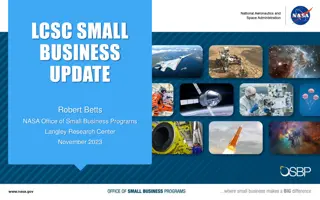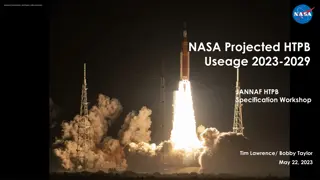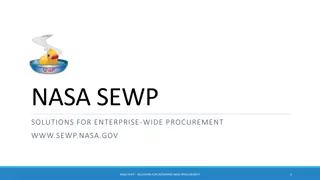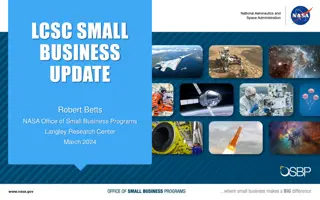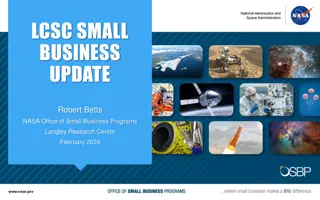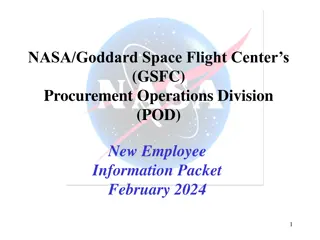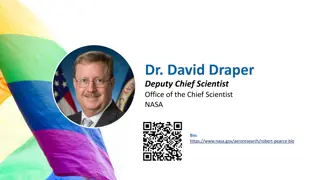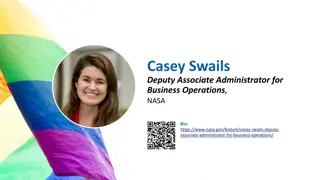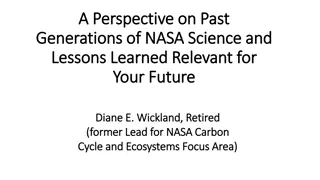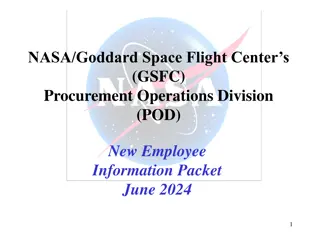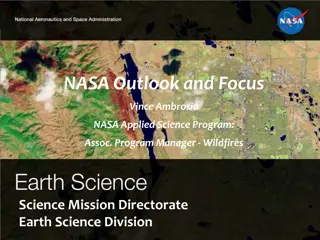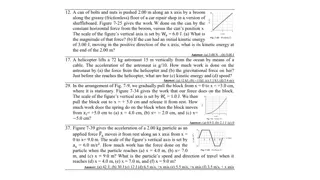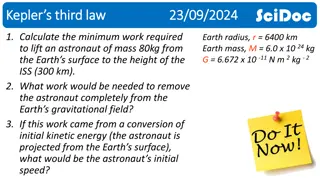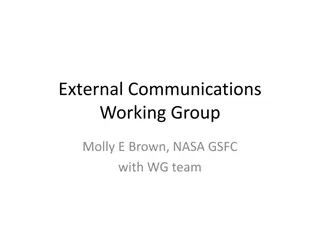NASA Astronaut Selection and Training Overview
Learn about the process of becoming a NASA astronaut, including requirements, selection process, and the history of astronaut selection. Explore the different categories of space flyers and the diverse backgrounds of astronauts. Discover the fascinating world of space exploration and the role of astronauts in NASA's vision for space exploration.
Download Presentation

Please find below an Image/Link to download the presentation.
The content on the website is provided AS IS for your information and personal use only. It may not be sold, licensed, or shared on other websites without obtaining consent from the author. Download presentation by click this link. If you encounter any issues during the download, it is possible that the publisher has removed the file from their server.
E N D
Presentation Transcript
NASA Astronaut Selection and Training: Overview by Felix.A.Soto-Toro@NASA.gov Kennedy Space Center Audit Liaison Representative November 14, 2023 1
Agenda Definition Categories Background Requirements Pay and benefits Frequently asked questions Typical interview activities Selection process timeline Number of astronauts selected by year Probability of being selected Recent composition of selected astronauts Building up your profile Where is their office ? What do astronauts do at work when they are not flying ? Some astronauts hobbies Recommendations Some useful websites 2
Definition of Astronaut The term "astronaut" derives from the Greek words meaning "space sailor," and refers to all who have been launched as crew members aboard NASA spacecraft bound for orbit and beyond. Since the inception of NASA's human space flight program, we have also maintained the term "astronaut" as the title for those selected to join the NASA corps of astronauts who make "space sailing" their career profession. The term "cosmonaut" refers to those space sailors who are members of the Russian space program. 3
Space Flyers Categories Classification Description Active U.S. astronauts who are currently eligible for flight assignment, including those who are assigned to crews. Management Experienced astronauts who have been promoted to other positions within NASA, or astronauts on special duty assignments or sabbaticals that make them unavailable for direct support to the Astronaut Office. Former Those who have left NASA after a career in the Astronaut Corps, including those who are deceased. International Those individuals from international space agencies who have trained at Johnson Space Center and serve as mission specialists with NASA. Astronauts: Arab Canada China Taikonauts Europe India Japan Cosmonauts: Russia Tourists . 5
Astronaut Selection Facts The first U.S. astronauts were selected in 1959, before human spaceflight operations began. NASA asked the military services to provide a list of personnel who met specific qualifications. After stringent screening, NASA announced its selection of seven men, all pilots, as the first American astronauts. NASA has selected 22 more groups of astronauts since the Mercury Seven. The backgrounds of NASA s latest group of Astronaut Candidates included university professors, doctors, scientist, engineers and pilots. Scott Carpenter, Gordon Cooper, John Glenn, Gus Grissom, Walter Schirra, Alan Shepard, and Deke Slayton. NASA selects astronauts from a diverse pool of applicants with a wide variety of backgrounds. From the thousands of applications received, only a few are chosen for the intensive Astronaut Candidate training program. Including the Mercury Seven , only 370 astronauts have been selected to date (2021). The astronauts of the 21st century will help lead NASA through the next steps of its Vision for Space Exploration as we explore the Moon, Mars, and beyond. 6
General Program Requirements 1) Selected applicants will be designated Astronaut Candidates and will be assigned to the Astronaut Office at the Johnson Space Center, Houston, Texas. 2) The astronaut candidates will undergo a training and evaluation period lasting Approximately 2 years, during which time they will participate in the basic Astronaut Candidate training program, which is designated to develop the knowledge and skills required for formal mission training upon selection for a flight. Astronaut Candidates (Piloting background) will maintain proficiency in NASA aircraft during their candidate period. (Applicant Candidate Astronaut penguin Flown Astronaut) 3) As part of the Astronaut Candidate training program, Astronaut Candidates are required to complete military water survival before beginning their flying syllabus, and become SCUBA qualified to prepare them for the EVA training. Consequently, all Astronaut Candidates will be required to pass a swimming test during their first month of training. They must swim 3 lengths of a 25-M pool without stopping, and then swim 3 lengths of the pool in a flight suit and tennis shoes. There is no time limit. They must also tread water continuously for 10 minutes. 7
General Program Requirements (continued) 4) Applicants should be aware that selection as an Astronaut Candidate does NOT ensure selection as an astronaut. Final selection as an astronaut will depend upon satisfactory completion of the training and evaluation period. Civilian candidates who successfully complete the training and evaluation and are selected as astronauts will become permanent Federal employees and will be expected to remain with NASA for a period of at least 5 years. 5) Civilian candidates who are NOT selected as astronauts may be placed in other positions within NASA, depending upon Agency requirements and labor constraints at that time. Successful military candidates will be detailed to NASA for a specified tour of duty. 6) NASA has an affirmative action program goal of having qualified minorities and women among those selected as Astronaut Candidates. Therefore, qualified minorities and women are encouraged to apply. 8
Minimum Requirements for Mission Specialists Position Astronaut requirements have changed with NASA's goals and missions. Today, to be considered for an astronaut position, applicants must meet the following qualifications: 1. Be a U.S. citizen 2. Possess a master's degree* in a STEM field, including engineering, biological science, physical science, computer science or mathematics, from an accredited institution. 3. Have at least two years of related professional experience obtained after degree completion or at least 1,000 hours pilot-in- command time on jet aircraft. 4. Be able to pass the NASA long-duration flight astronaut physical. *The master's degree requirement can also be met by: Two years (36 semester hours or 54 quarter hours) of work toward a doctoral program in a related science, technology, engineering or math field. A completed Doctor of Medicine or Doctor of Osteopathic Medicine degree. Completion (or current enrollment that will result in completion by June 2021) of a nationally recognized test pilot school program. Astronaut candidates must also have skills in leadership, teamwork and communications. NASA s Astronaut Selection Board reviews the applications (a record-breaking 18,300 applications in 2016) and assesses each candidate s qualifications. The board then invites a small group of the most highly qualified candidates for interviews at NASA's Johnson Space Center in Houston, Texas. Of those interviewed, about half are invited back for second interviews. From that group, NASA s new astronaut candidates are selected. They report for training at Johnson and spend the next two years learning basic astronaut skills like spacewalking, operating the space station, flying T-38 jet planes and controlling a robotic arm. With NASA's plans for the future of exploration, new astronauts will fly farther into space than ever before on lunar missions and may be the first humans to fly on to Mars. 9
Minimum Requirements for Pilots Position Astronaut Candidate (Piloting background) Bachelor s degree from an accredited institution in engineering, biological science, physical science or mathematics. An advanced degree is desirable. Quality of academic preparation is important. At least 1,000 hours pilot-in-command time in jet aircraft. Flight test experience is highly desirable. Ability to pass the NASA long-duration space flight physical which includes the following specific requirements: Pilot (Applicants with less than Jet aircraft pilot licenses do NOT qualify for this position) Distant visual acuity: Must be correctable to 20/20, each eye (NOTE: For those applicants under final consideration, additional visual screening will be performed to include the following standards: refractive error (distant vision)-cycloplegic refractive error must be between +3.50 and -4.00 diopters in any meridian. Astigmatism may require up to 2.00 diopters of cylinder correction. Anisometropia of up to 2.50 diopters. You are not required to provide this information with your initial application. We will request it later if needed.) frequent flyer miles do not count, sorry ! Near visual acuity: Must be correctable to 20/20 each eye The refractive surgical procedures of the eye, PRK and LASIK, are now allowed, providing at least 1 year has passed since the date of the procedure with no permanent adverse after effects. For those applicants under final consideration, an operative report on the surgical procedure will be requested. Blood pressure not to exceed 140/90 measured in a sitting position Standing height between 62 and 75 inches (5 2 and 6 3 ) 10
Pay and Benefits for Astronaut Candidates Source Guidelines Starting in 2021, salaries for civilian Astronaut Candidates are based on the NASA Excepted (NEX) authority, due to the unique nature of their jobs, duties, work roles, requirements, and other aspects of carrying out mission assignments. Though NASA continues to recruit astronauts with diverse skills sets and experience levels, all astronaut candidates begin astronaut training at the same level; no one has prior experience as an astronaut, so all astronaut candidates start at the same rate of pay. The current pay structure ranges from $141,888 to $183,300. Pay increases are tied to specific, job-related milestones, such as successful completion of all astronaut training requirements. Civilian Military Astronaut Candidates are detailed to the Johnson Space Center and remain in an active duty status for pay, benefits, leave, and other similar military matters. Military 11
Frequently Asked Questions (FAQs) General FAQs Education FAQs Medical FAQs Military FAQs Application FAQs 12
Typical Interview Activities Monday 13
Typical Interview Activities (Continued) Additional activities: Essay Panel Interview Individual Interviews and it is not inserted through your mouth Nurse Mona & Dr. Hein X-Rays MRI (new) and more Not looking forward for this !!! 14
Typical Interview Activities (Continued) Additional activities: Essay Panel Interview Individual Interviews and it is not inserted through your mouth Nurse Mona & Dr. Hein X-Rays MRI (new) and more 15
Astronaut Candidate Selection Process Timeline (Continued) Levels of notification: Amount of Candidates March 2, 2020 Vacancy Announcement opens in USAJOBS 1st March 31, 2020 Vacancy Announcement closes 12,000+ applications Qualified Applications reviewed to determine Highly Qualified applicants. Qualifications Inquiry form sent to Supervisors/References. April July 2020 2,400 (Top 20%) 2nd September 2020 April 2021 Highly Qualified applications reviewed to determine Interviewees 400 (Top 3.3%) 3rd Interviewees brought to JSC for initial interview, medical evaluation, and orientation. Interviewees will be selected from the Highly Qualified group and contacted on a week-by-week basis. 120 (Top 1.0%) May - July 2021 4th August - September 2021 Finalists determined 40 (Top 0.33%) 5th 6th Astronaut Candidate Class of 2021 announced. Also knows as The Flies . Previous class was The Turtles . December 2021 12 (Top 0.10%) Group #23 January 2022 Astronaut Candidate Class of 2021 reports to the Johnson Space Center 7th and yes, Astronauts have to move to Texas ! 16
Number of astronauts in office in each year of selection Group Size vs Selection Year 40 35 30 25 20 15 10 5 0 The Bugs 19 + 80 The Hogs Turtles The Fourteen The Sardines The GAFFers The Chumps Next Nine and the New Nine The Scientists Eight Balls The Flies The Peacocks The Original 19 The Penguins The Hairballs Excess Eleven TFNG (Thirty-Five New Guys) The Maggots Original Seven The Flying Escargot Group s Nickname Group # 1 2 3 4 5 6 7 8 9 10 11 12 13 14 15 16 17 18 19 20 21 22 23 1959 1962 1963 1965 1966 1967 1969 1978 1980 1984 1985 1987 1990 1992 1995 1996 1998 2000 2004 2009 2013 2017 2021 Year Selected Pilots Mission Specialists Educators Total As of 10/24/2023, there are 39 active astronauts (not including class #23) 18
If you applied, what would be your chances of being part of the 2021 Astronaut Candidate Class ? Position Odds* Percentage Pilot 5 / 12,000 0.042% Mission Specialist 5 / 12,000 0.042% *Assuming exclusive probability or 10 Astronaut Candidates selected. 19
2021 Astronaut Candidate Group #23 Age* Classification Affiliation Education / Former Job Astronaut s Name Nichole Ayers Pilot Air Force Fighter Pilot BS degree in mathematics. MS in computational and applied mathematics from Rice University in Houston. 32 1 Marcos Berrios Pilot Air Force Helicopter Test Pilot BS in mechanical engineering from MIT, MS in mechanical engineering and PhD in aeronautics and astronautics from Stanford University in California. 36 2 Christina Birch Mission Specialist Bioengineer, Team USA Track Cyclist BS in mathematics & biochemistry and molecular biophysics from the University of Arizona, minor in Spanish. Doctorate in biological engineering from MIT. 35 3 Deniz Burnham Mission Specialist Drilling Engineer BS in chemical engineering from the University of California. MS in mechanical engineering from the University of Southern California. 36 4 Luke Delaney Pilot NASA Langley Research Pilot BS in Mechanical Engineering from University of North Florida. MS in Aerospace Engineering from the Naval Postgraduate School in California. 41 5 Andre Douglas Mission Specialist Space Systems Engineer BS in mechanical engineering, U.S. Coast Guard Academy in Connecticut. MS in mechanical engineering, University of Michigan. MS in naval architecture and marine engineering, University of Michigan. MS in electrical and computer engineering, Johns Hopkins University. Doctorate in systems engineering, George Washington University. 34 6 Jack Hathaway Mission Specialist Navy Test Pilot BS in physics and history from the U.S. Naval Academy. MS in flight dynamics from Cranfield University. Master s in national security and strategic studies from the U.S. Naval War College. Empire Test Pilot s School in 2011, part of Fixed Wing Class 70. 38 7 Anil Menon Mission Specialist Medical Director, SpaceX BS in Neurobiology, Harvard University, Massachusetts. MS in Mechanical Engineering, Stanford University, California. Doctor of Medicine, Stanford Medical School, 2006. Residency in Emergency Medicine, Stanford University, 2009. Fellowship in Wilderness Medicine, Stanford University, 2010. Residency in Aerospace Medicine, University of Texas. Master s in Public Health, UTMB-Galveston. 44 8 Christopher L:. Williams Mission Specialist Medical Physicist BS in physics from Stanford University. Doctorate in physics from MIT. Residency training at the Harvard Medical Physics Residency Program. 37 9 Jessica Wittner Pilot Navy Test Pilot, Research Engineer BS in Aerospace Engineering, University of Arizona. U.S. Naval Test Pilot School (Class 150), Maryland. MS in Engineering Science (Aerospace Engineering), U.S. Naval Postgraduate School. Naval Command and Staff Graduate, U.S. Naval War College. 37 10 There are no age restrictions for the program. Astronaut candidates selected in the past have ranged between the ages of 26 and 46, with the average age being 35. *The 2021 US class age average: 37 years old. Age Spectrum: 32 44. 20
2017 Astronaut Candidate Group #22 Age* Classification Affiliation Education / Former Job Astronaut s Name Kayla Barron 30 Mission Specialist Lt. U.S. Navy. 1 Master s degree in Nuclear Engineering from the University of Cambridge. Zena Cardman Bachelor of Science degree in Biology and Master of Science degree in Marine Sciences at The University of North Carolina, Chapel Hill 30 Mission Specialist The University of North Carolina, Chapel Hill 2 Raja Chari 40 Pilot U.S. Naval Test Pilot School 3 Master s degree in Aeronautics and Astronautics from Massachusetts Institute of Technology and graduated from the U.S. Naval Test Pilot School. Matthew Dominick Bachelor of Science in Electrical Engineering from the University of San Diego and a Master of Science degree in Systems Engineering from the Naval Postgraduate School. He graduated from U.S. Naval Test Pilot School. 36 Pilot U.S. Naval Test Pilot School 4 Bob Hines 42 Pilot University of Alabama 5 U.S. Air Force Test Pilot School, where he earned a Master s Degree in Flight Test Engineering. He continued on to earn a Master s degree in Aerospace Engineering from the University of Alabama. Warren Hoburg 32 Mission Specialist University of California, Berkeley 6 Bachelor s degree in Aeronautics and Astronautics from the Massachusetts Institute of Technology (MIT) and a Doctorate in Electrical Engineering and Computer Science from the University of California, Berkeley. Dr. Jonny Kim Navy SEAL, completing more than 100 combat operations and earning a Silver Star and Bronze Star with Combat V . Afterward, he went on to complete a degree in Mathematics at the University of San Diego and a Doctorate of Medicine at Harvard Medical School. 33 Mission Specialist Doctorate of Medicine at Harvard Medical School 7 Dr. Robb Kulin Master s degree in Materials Science, and a doctorate in Engineering, both from the University of California, San Diego. Resigned from NASA, effective August 31, 2018, before completing astronaut training. 34 Mission Specialist Launch Chief Engineer, SpaceX 8 Jasmin Moghbeli 34 Mission Specialist Naval Postgraduate School. 9 Bachelor s degree in Aerospace Engineering with Information Technology at the Massachusetts Institute of Technology, followed by a Master s degree in Aerospace Engineering from the Naval Postgraduate School. Bachelor of Science degree in Aerospace Engineering at the University of Kansas and a Master of Science degree in Aeronautics and Astronautics from Purdue University. 34 Mission Specialist Purdue University 10 Loral O Hara Dr. Francisco Rubio U.S. Military Academy and earned a Doctorate of Medicine from the Uniformed Services University of the Health Sciences. 42 Mission Specialist Uniformed Services University of the Health Sciences 11 Dr. Jessica Watkins 29 Mission Specialist University of California, Los Angeles (UCLA) 12 Bachelor s degree in Geological and Environmental Sciences at Stanford University, and a Doctorate in Geology from the University of California, Los Angeles (UCLA). There are no age restrictions for the program. Astronaut candidates selected in the past have ranged between the ages of 26 and 46, with the average age being 35. *The 2017 US class age average: 35 years old. Age Spectrum: 29 42. 21
2013 Astronaut Candidate Group #21 Age* Classification Affiliation Former Job Astronaut s Name Josh A. Cassada, Ph. D. 39 Pilot U.S. Navy. University of Rochester, NY Naval aviator. Physicist by training and previously served as co-founder and Chief Technology Officer for Quantum Opus. 1 Victor J. Glover 37 Pilot U.S. Navy. California Polytechnic State University, San Luis Obispo, Calif.; Air University and Naval Postgraduate School F/A-18 pilot and graduate of the U.S. Air Force Test Pilot School. 2 Tyler N. Hague (Nick) 37 Pilot U.S. Air Force Academy, Massachusetts Institute of Technology, and the U.S. Air Force Test Pilot School, Edwards, Calif. Department of Defense as Deputy Chief of the Joint Improvised Explosive Device Defeat Organization 3 Christina M. Hammock 34 Mission Specialist North Carolina State University, Raleigh, N.C. National Oceanic and Atmospheric Administration (NOAA) Station Chief in American Samoa. 4 Nicole Aunapu Mann 35 Pilot U.S. Marine Corps. U.S. Naval Academy, Stanford (Calif.) University and the U.S. Naval Test Pilot School F/A 18 pilot, currently serving as an Integrated Product Team Lead at the U.S. Naval Air Station, Patuxent River. 5 Anne C. McClain 34 Pilot U.S. Army. U.S. Military Academy at West Point, N.Y.; the University of Bath and the University of Bristol, both in the United Kingdom OH-58 helicopter pilot, and a recent graduate of U.S. Naval Test Pilot School at Naval Air Station, Patuxent River. 6 Jessica U. Meir, Ph.D. 35 Mission Specialist Brown University, has an advanced degree from the International Space University, and earned her doctorate from Scripps Institution of Oceanography Assistant Professor of Anesthesia at Harvard Medical School, Massachusetts General Hospital, Boston. 7 Andrew R. Morgan, M.D. 37 Mission Specialist U.S. Army. U.S. Military Academy at West Point, and earned doctorate in medicine from the Uniformed Services University of the Health Sciences Emergency physician and flight surgeon for the Army special operations community, and currently is completing a sports medicine fellowship. 8 There are no age restrictions for the program. Astronaut candidates selected in the past have ranged between the ages of 26 and 46, with the average age being 35. *The 2013 US class age average: 36 years old. Age Spectrum: 34 39. 22
My Astronaut Application Progress: Increasing my Odds ??? Attempt # (my age) Degrees completed at time of application Year Other Activities Comments 1 Did not meet minimum requirements (3 years of professional experience) 1991 BS in Electrical Engineering Graduate studies (24) 2 BS in Electrical Engineering MS in Engineering Management Eligible to apply ! Levels advanced: 1. Levels to go: 8 1993 College Professor (26) 3 BS in Electrical Engineering MS in Engineering Management 1995 Robotics & Automation Did not advance to the next level (28) BS in Electrical Engineering MS in Engineering Management MS in Electrical Engineering 4 1997 College Professor Did not advance to the next level (30) BS in Electrical Engineering MS in Engineering Management MS in Electrical Engineering 5 1999 American Sign Language, SCUBA Did not advance to the next level (32) BS in Electrical Engineering MS in Engineering Management MS in Electrical Engineering Ph.D. in Electrical Engineering 2001 College Professor, Research No Class Selection this year 6 Advanced to the next level ! Levels advanced: 2. Levels to go 3 2003 BSEE, MSEM, MSEE, PhDEE Project Management Professional Certification (36) 2005 BSEE, MSEM, MSEE, PhDEE College Professor, NASA Fellowship No Class Selection this year 7 College Professor, Private Pilot, Multi-Center Project Experience, Russian Language 2008 BSEE, MSEM, MSEE, PhDEE Back to square 1 ! (41) 8 2012 BSEE, MSEM, MSEE, PhDEE Orion Capsule EGSE Lead Did not advance to the next level (45) 9 Added flying hours, worked for the Center Director s Office 2016 BSEE, MSEM, MSEE, PhDEE Did not advance to the next level (49) 10 (54) 2021 BSEE, MSEM, MSEE, PhDEE Worked for the HQs Mission Support Directorate Did not advance to the next level 23
Will you be prepared ? Degree must be followed by at least 3 years of related, progressively responsible, professional experience or at least 1,000 pilot-in-command time in jet aircraft. Year Your Age Academic Level Professional Experience Step 2023 20 Undergraduate student 0 years 1 An advanced degree is desirable and may be substituted for experience as follows: master s degree = 1 year of experience, doctoral degree = 3 years of experience. 2025 22 Start Graduate school 0 years 2 2027 24 Graduate with Masters Degree 2 years 3 2028 25 Start Doctoral Degree 3 years 4 Eligible to apply to become an Astronaut 2030 27 Graduate with Doctoral Degree 5 years 5 (Selected as an Astronaut) 2032 30 6 Selected for Mars Exploration Program ! NASA has a need to fulfill ! There are only 39 (Active: 16 females + 23 males) Attrition rate: 8 per year 24
What do Astronauts do at work when they are not flying? Training for their missions Help others train for their missions 26
Astronaut Training The water within the NBL is recycled every 19.6 hours. It is automatically monitored and controlled to a temperature of 82-88 degrees Fahrenheit to minimize the potential effects of hypothermia on support divers. It is also chemically treated to control contaminant growth while minimizing long-term corrosion effects on training mockups and equipment. Neutral Buoyancy Laboratory (NBL). The NBL was sized to perform two activities simultaneously; each uses mockups sufficiently large to produce meaningful training content and duration. It is 202 ft in length, 102 ft in width, and 40 ft in depth (20 ft above ground level and 20 ft below) and holds 6.2 million gallons of water. Even at this size, the International Space Station, at 350 ft x 240 ft when complete, will not fit inside the NBL. 27
What do Astronauts do at work when they are not flying? (continued) Support mission from ground Mission Control Be with family & VIP during missions Support design reviews Participate in Brainstorming activities Support fit checks Familiarize with Spacecraft systems Familiarize with ISS systems Travel to ISS partners countries Public Affairs & Education Outreach Maintain flying proficiency Conduct Research Familiarize with Robotics and Flight Simulation H/W & S/W and much more ! NEEMO 11 crew 28
What do Astronauts do at work when they are not flying? (continued) 29
What do Astronauts do when they are NOT flying ? (continued) Divide and Conquer ! 30
What do some Astronauts do when they are NOT flying ? (continued) Auto Repair Astronomy Basketball Baseball Bike Mountain Bicycling Camping Collecting Stamps Collecting Toy Trains Cooking Drawing and Painting Exploring Physics Flying Small Planes Hiking Home Improvement Jogging Learning Languages Golfing Playing Musical Instruments Photography Reading Rock Climbing Sailing SCUBA Diving Sewing Singing Soccer Softball Snow Skiing Spending Time With Loved Ones Swimming Tap and Jazz Dancing Tennis Theatre Volleyball Water Skiing Weight Training Wind Surging Writing Software 31
Astronauts Test Subjects (continued) Help with design of new vehicles 33
Recommendations Your goal to becoming an Astronaut should not be your only goal in life ! Have faith in God ! Obtain training that will benefit both you and your employer Establish interesting, hard to attain but reasonable goals Be a role model Promote mentorship Share your knowledge Maintain a clean mind and a healthy body Maintain a good attitude, it might dictate your altitude ! Respect others Balance your life Apply gained skills in your personal and professional life. 34
Some Useful Websites NASA Fact Sheet Library https://www.nasa.gov/content/digital-library-fact-sheets NASA Agency Wide Jobs http://www.usajobs.gov/ Astronaut Fact Book http://www.nasa.gov/pdf/740566main_current.pdf Becoming an Astronaut Astronaut Frequently Asked Questions https://www.nasa.gov/feature/frequently-asked-questions-0/ Astronaut Selection Timeline https://www.nasa.gov/image-feature/astronaut-selection-timeline Astronaut Hopefuls (non-NASA site) a profile may be created to view content. https://www.reddit.com/r/AstronautHopefuls/ Interesting Statistics on Astronauts (non-NASA site) a profile may be created to view content. https://towardsdatascience.com/reddits-dataviz-battle-nasa-astronaut-eda-6f34a59962e 35
Is the next Astronaut in this picture? Insert picture of audience here 36
THANK YOU ! - Suggestions ? - Questions ? - Comments ? Felix.A.Soto-Toro@NASA.gov 37




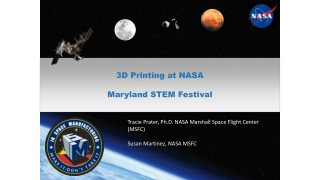
![[PDF⚡READ❤ONLINE] Gemini 4: An Astronaut Steps into the Void (Springer Praxis B](/thumb/21620/pdf-read-online-gemini-4-an-astronaut-steps-into-the-void-springer-praxis-b.jpg)
